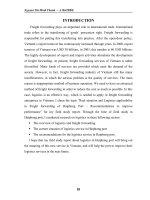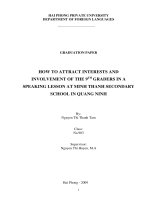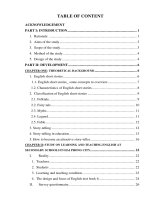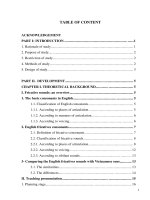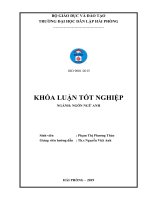How to assist Haiphong secondary pupils in pronouncing English fricative sounds
Bạn đang xem bản rút gọn của tài liệu. Xem và tải ngay bản đầy đủ của tài liệu tại đây (1.57 MB, 77 trang )
1
TABLE OF CONTENT
ACKNOWLEDGEMENT
PART I: INTRODUCTION 1
1. Rationale of study 1
2. Purpose of study 2
3. Restriction of study 2
4. Methods of study 2
5. Design of study 3
PART II. DEVELOPMENT 5
CHAPTER I. THEORETICAL BACKGROUND 5
I. Fricative sounds: an overview 5
1. The basic consonants in English 5
1.1. Classification of English consonants 5
1.1.1. According to places of articulation 5
1.1.2. According to manners of articulation 6
1.1.3. According to voicing 6
2. English fricatives consonants 7
2.1. Definition of fricative consonants 7
2.2. Classification of fricative sounds 8
2.2.1. According to places of articulation 8
2.2.2. According to voicing 12
2.2.3. According to sibilant sounds 13
3- Comparing the English fricatives sounds with Vietnamese ones 13
3.1. The similarities 13
3.2. The differences 14
II. Teaching pronunciation 15
1. Planning stage 16
2
2. Teaching stage 16
2.1. Descriptions and analysis 16
2.2. Techniques in teaching pronunciation 17
2.2.1. Listening 17
2.2.2. Using pictures 17
2.2.3. Telling story 18
2.2.4. Song completion 18
2.2.5. Communicative practices 18
2.2.6. Bingo game 19
2.2.7. Minimal pairs of words 19
2.2.8. Gap fill poems 20
CHAPTER II. A STUDY ON HOW ENGLISH FRICATIVE SOUNDS ARE
STUDIED AND TAUGHT BY TEACHERS AND STUDENTS IN HAI
PHONG SECONDARY SCHOOL 21
I. Reality 21
1. Teachers and pupils 21
1.1. Teachers 21
1.2. Students 21
2. Teaching and learning condition 22
3. The design of English textbook 22
II. Survey questionnaires 23
1. Purpose of survey questionnaires 24
2. Design of survey questionnaires 24
3. Data analysis 25
3.1. Students‟ and teachers‟ opinion on English pronunciation stage in general
and English fricative sound in particular 25
3.1.1. The importance of teaching English pronunciation 25
3.1.2. Students‟ outlook on English fricative sounds .25
3.1.3. The necessity of English fricative sounds 26
3
3.1.4. The difficult levels of English fricative sounds 27
3.2. Current situation of teaching and learning English fricative sounds 28
3.2.1. Teachers frequency of teaching English fricative sounds 28
3.2.2. When to teach students to pronounce English fricative sounds 29
3.2.3. The ways students pronounce English fricative sounds 30
3.3. Students‟ and teachers‟ view points on currently used techniques in
teaching English fricative sounds 31
3.3.1. Frequency of currently used techniques 31
3.3.2. The effectiveness of teachers‟ techniques 32
3.4. The difficulties students faced when studying English fricative . 34
3.5. Students‟ expectations toward learning English pronunciation 35
III. Finding and the discussion of finding 36
CHAPTER III. APPLICATION OF SOME TECHNIQUES TO ASSIST HAI
PHONG SECONDARY STUDENTS IN PRONOUNCING ENGLISH
FRICATIVE SOUNDS 39
1. Listening 39
1.1. Listen to discrimination 39
1.2. Listen to music 42
2. Using story 43
2.1. Retell story 43
2.2. Gap the story 45
2.3. Making up stories 46
3. Studying through games 46
3.1. Tongue-twisters 46
3.2. Matching words 48
3.3. Run and write 50
3.4. The family tree 50
3.5. Wordsearch puzzle 50
3.6. Alphabet word game 51
4
3.7. Word challenging 52
3.8. Pronunciation Bingo 53
3.9. Circle words games 54
3.10. Pronunciation Pyramid 56
3.11. Hangman 56
3.12. Missing letters words 57
3.13. IPA symbol card game 58
3.14. The Bell game 59
PART III. CONCLUSION 61
APPENDICE
APPENDIX 1: The survey questionnaires for students
APPENDIX 2: The interview question for teachers
APPENDIX 3: A model lesson plan
REFERENCES
5
ACKNOWLEDGEMENTS
During the process of fulfilling my graduation paper, I have been fortunate
to receive a great deal of assistance, guidance and encouragement from many
people.
First and most of all, I would like to express my deepest thanks to Mrs.
Nguyen Thi Huyen, MA, my supervisor, for her guidance, great suggestion and
precious comment in each step of the study to help me complete my graduation paper.
Also, my sincere thanks is extended to all teachers in Foreign Language
Department, Hai Phong Private University for their useful lectures and
suggestions.
Besides, my special thanks send to all teachers and students in Dang Hai,
Nam Hai, Dong Hai and Dang Lam secondary school for their enthusiasm in
finishing the survey questionnaires
Last but not least, I am really in debt to my family and friends who have
motivated me during the time I carried out this paper.
Hai Phong, June, 2009
Student
Nguyen Thi Hanh
6
PART I. INTRODUCTION
1. Rationale of study
In the developing social-economic background, Vietnam is gradually
integrating into the worldwide so English becomes more necessary and most
students must study English as compulsory subject. However, almost students
learn it passively because their English is only remarkable in grammar or other
skills and their listening or speaking ones are not good because of pronunciation.
Pronunciation is an important part for learner and it is the biggest thing that
people notice about your English. So having a good and correct pronunciation is a
stable foundation to study and communicate.
Nowadays, English is taught in all levels but not everyone pays attention in
standard pronunciation for pupils in schools. So that pupils lacks of the knowledge
and do not know how to pronounce a word correctly. Furthermore, pronunciation
is not the main skill taught at schools, students only pronounce new words
following the teachers even they do not know why.
So that it may lead to a serious consequence, which can makes students
pronounce English sounds wrongly from the lower level to higher ones. Add to
that this habit in pronunciation English can cause the misunderstanding for
students when communicating with foreigner language.
It is the main reason why student always fells shy or afraid of talking in class
or meets difficulties in listening stage.
Despite the awareness of its role, teachers only teach students to pronounce
English sounds by reading new words or text passages and students become
passive in this case. Therefore, students can memorize many words but the rate of
exactly pronunciation is in inverse proportion.
In addition, teachers think that teaching students the transcription of words is
impossible because they cannot ask their students remember all the words‟
transcription they have learned. However, if we find out the simple and interesting
methods to represent English sounds to students, it will become more attractive to
learn.
7
Being a student of English Department, I always concern about this problem
because I myself also make mistakes when speaking English, therefore I decide to
study deeply about English fricative consonants to make it clear and simple to help
secondary pupils and create a change for me to improve my English pronunciation.
For these reasons, I have chosen the subject “How to assist Hai Phong
secondary pupils in pronouncing English fricative sounds”
2. Purpose of study
The purpose of the study focus on helping secondary pupils to have more
specific and clear understanding of English fricative sounds and find out the
method to learn them effectively:
Studying on the basic theories of English fricatives sounds, compare the
fricatives sounds in English and Vietnamese and the characteristics of teaching
pronunciation.
The real situation of teaching and study English pronunciation in Hai Phong
secondary school is surveyed.
The most important aim is application of some effective activities in class to
help students study English fricative sounds as well as other ones better.
3. Restriction of study
English pronunciation is a large aspect; however, because of limited time and
knowledge, the study only focus on how to help students at Hai Phong secondary
schools learn English fricative sounds in separated words and offering appropriate
techniques to help students can pronounce them accurately in this paper. So that
the intonation as well as the stress parts will be expected explored in further study.
4. Methods of study
With the purpose of making English fricative sounds specifically and simply for
pupils, my research methods are:
Reference books related to English consonant sounds and teaching
pronunciation are review to get background knowledge of fricative sounds and
8
some interesting techniques in teaching pronunciation.
A survey is carried out for four grades: 6
th
, 7
th
, 8
th
, 9
th
in Nam Hai, Dong
Hai, Dang Hai, Dang Lam secondary schools to explore their opinion on English
fricative sounds and the difficulties they faced as well as their expectation toward
learning English pronunciation.
The information of the survey will be gathered from survey questionnaires
for students and interview questions for teachers.
Basing on the currently situation of learning and teaching English fricative
sounds in these schools, the writer gives some suggested techniques in order to
help students in this case.
5. Design of the study
The study consists of three parts: Introduction, Development and Conclusion.
Part 1: The Introduction part points out the rationale of the study, the
purpose, the restriction, methods and design of the study.
Part 2: Development involves three chapters:
Chapter I: “Theoretical background” gives us the general overview in
English fricative sounds and the introduction about teaching English pronunciation.
Chapter II: “Study on how English fricative sounds are studied and
taught by teachers and students in Hai Phong secondary schools” reflects the
students‟ and teachers‟ viewpoints and the situation of teaching and learning English
sounds in general and fricative ones in particular in Hai Phong secondary schools.
Chapter III: “Application of some techniques to assist Hai Phong
secondary students in pronouncing English fricative sounds” supplies the
suggested techniques in teaching and learning fricative sounds in an easy and
interesting manner to help students get the best effectiveness from them.
Part 3: Conclusion summarizes all the part mentioned in the paper and some
suggestion for further study.
To sum up, Part 1 has introduced the content of the study. In part II, the
writer will analyze more specifically about English fricative sounds and the survey
9
questionnaires carried out in Hai Phong secondary schools, which reveal us the
situation of teaching and learning English fricative sounds. Additional, Part II also
suggests some techniques applied in order to help student learn English
pronunciation of sounds better.
10
PART II. DEVELOPMENT
CHAPTER I. THEORETICAL BACKGROUND
I. Fricative sounds an overview
1. The basic consonants in English
Consonants are the sounds in the productions of which the articulators move
toward another or the articulators come together obstructing the air stream so the
air stream cannot get out freely.
In English alphabet, there are 25 basic consonants:
/b/, /p/, /d/, /t/, /g/, /k/, /v/, /f/, /ð/, /θ/, /z/, /s/, /ʃ/, /ʒ/,/ tʃ/, /dʒ/, /h/, /m/, /n/, /l/, /r/,
/w/, /hw/, /y/
1.1- Classification of English consonants
Three major features used to distinguish consonants are Places of articulation,
manners of articulation, and voicing.
1.1.1- According to places of articulation
The place of articulation (also point of articulation) of a consonant is the point of
contact, where an obstruction occurs in the vocal tract between an active articulator
and the passive articulator.
There are nine groups of consonants classified according to place of
articulation:
- Bilabial sounds: are the sounds made with two lips: /b ,m ,p, w/
- Labio-dental sounds: are the sounds made with the lower lip and the upper
front teeth: /f, v/
- Dental sounds: are the sounds made with tip of the tongue and the upper
front teeth: /ð, θ/
- Alveolar sounds: are the sounds made with tip of the tongue and the alveolar
ridge, the tip of the tongue is moved to the alveolar ridge: /t, d, n, l, s, z/
- Alveolar-palatal sounds: are the sounds made with the palate of the tongue
and the back of the alveolar ridge: /ʃ, ʒ, tʃ, dʒ/
11
- Palatal sounds: are the sounds made with the front of the tongue and the hard
palate: / j/
- Velar sounds: are the sounds made with the back of the tongue and the soft
palate: /k, g, ŋ/
- Glottal sounds: This sound is made at the epiglottis: /h/
- Retroflex sounds: are the sounds made with the tip of the tongue and the
Aback of the alveolar: /r/
1.1.2- According to manners of articulation
Manner of articulation describes how the tongue, lips, and other speech organs
involved in making a sound make contact.
There are seven groups of consonants classified according to manners of
articulation:
- Stop/Plosive: Are the sounds made by the air that passes from the lung into
the mouth being completely stopped: /p, b, t, d, k, g/
- Affricatives: Are the sounds made when a stop followed immediately by a
fricative sound made the same part in the mouth: / tʃ, dʒ/
- Fricative sounds: Are the sounds produced by forcing the air stream through
a narrow opening: /f, v, ð, θ, s, z, ʃ, ʒ, h/
- Nasal sounds: are the sounds made with the airs escaping through the nose:
/m, n ,ŋ/
- Lateral sounds: are the sounds made with the air passing through the mouth
over the sides of the tongue: /l/
- Retroflex sounds : Are the sounds made with the tip curled back in the
mouth:/r/
- Semi-vowels: Are the sounds made with the air stream partially obstructed
but not enough to cause friction: /w, j/
1.1.3- According to voicing
Sounds that are made with the vocal cords vibration are voiced and sounds made
with no vibration are voiceless.
12
All of the stops, fricatives, and affricatives come in voiced/voiceless pairs. The
nasals, lateral, retroflex and semi-vowels are all voiced.
There are 3 groups of consonants in term of voicing:
- Classification of stops in term of voicing:
Voiced: /b, d, g/
Voiceless: /p, t, k/
- Classification of fricatives in term of voicing:
Voiced: /v, ð/, z, ʒ, h/
Voiceless: /f, θ, s, ʃ/
- Classification of affricatives in term of voicing:
Voiced: /dʒ/
Voiceless: / tʃ/
2. English fricative consonants
CONSONANTS: FRICATIVES
Fig 1 – Cut away view of the vocal tract with places of articulation of fricatives
2.1- Definition of fricative consonants
There are many authors who define the English fricative consonants, some
of the most typical definitions are listed as following:
Fricatives are consonants with the characteristic that when they are
13
produced, air escapes through a small passage and makes a hissing sound.
[English phonetics and phonology, by Peter Roach]
Fricatives are produced where two articulators come close together but there
is still a small opening between them so that the air stream is partially obstructed
and an audible friction noise is produced.
Fricative are some consonants not involve a complete stoppage of the air
stream but rather a partial obstruction which results from the lips of the tongue
coming close to some part of the upper mouth. The close approximation of the
articulators causes turbulence or friction in the airflow.
[Teaching American English pronunciation, by Peter Avery and Susan Ehrlich]
Fricatives are consonants produced by forcing air through a narrow channel made
by placing two articulators close together. This turbulent airflow is called
frication
en.wikipedia.org/wiki/Fricative
Fricatives are consonants that are formed by impeding the flow of air
somewhere in the vocal apparatus so that a friction-sound is produced. Because of
the way the flow of breath is heard in producing fricatives, fricatives are also called
spirants. All fricatives, except /h/, come in pairs, i.e. one Fortis and one Lenis variant.
Fricatives may be voiced (vocal cords vibrating during the articulation of the fricative)
or voiceless (vocal cords not vibrating during the articulation of the fricative).
2.2- Classification of fricative sounds
There are 9 fricative consonants consisting of: /f/, /v/, /ð/, /θ/, /s/, /z/, /ʃ/, /ʒ/, /h/
Fricative consonants have the same manners of articulation but they can be
described and differentiated from each other by using three main classifications:
place, voice of articulation and sibilant sounds.
2.2.1- According to places of articulation
There are five groups of fricative consonants according to places of
articulation:
Labio-dental

